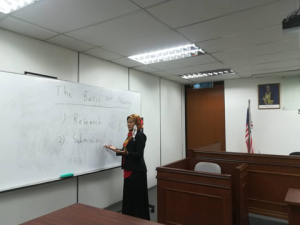By Ms Hetty Susilawati BT Asmuni, Lecturer, Faculty of Law
A student’s life in the classroom revolves around listening to lectures, answering tutorial questions and small group discussions to test his/her understanding of a particular topic. These conventional methods have obviously worked, but studying law is no longer confined to the classroom.
One of the compulsory yet exciting activities for law students is mooting. Mooting is a mock-court procedure in which students will dress up like professional lawyers and play their roles as prosecutor and defence attorneys to argue about legal issues or points of law before a judge. This procedure imitates real-case hearings in court. Before each of these proceedings begins, the judge will enter and all members in the court must stand as a gesture of respect to the legal system. It is a deathly completely silent moment when 8you could even hear a pin drop in the court. After the judge reaches his bench, all members in the court will bow to each other. The argumentative session starts thereafter. This is when their skills are tested before becoming a future lawyer.
Mooting is undeniably necessary for several reasons. Unlike classroom lessons, mooting exposes students to actual court scenes. It reflects the real-life experience of becoming a lawyer, wearing the black-and-white legal robe and following the accepted etiquette. Mooting is a platform to demonstrate the law student’s speaking, debating, analysing and advocacy skills as well as honing in on them them throughout the process. Becoming a lawyer is not just a profession. There is a lot more to it than meets the eye.
Mooting is not a new thing in most universities or college law schools including Segi College. Mooting is a compulsory subject in the syllabus. Most law schools hold inter-college competitions regularly to expose law students to real-life court scenes and proceedings.




